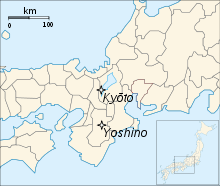Kannō
| History of Japan |
|---|
Kannō (観応), also sometimes romanized as Kan'ō, was a Japanese era name (年号, nengō, lit. year name) of the Northern Court during the Era of Northern and Southern Courts after Jōwa and before Bunna. This period spanned the years from February 1350 through September 1352.[1] The emperor in Kyoto was Emperor Sukō (崇光天皇 Sukō-tennō).[2] Go-Kōgon's Southern Court rival in Yoshino during this time-frame was Emperor Go-Murakami (後村上天皇 Go-Murakami-tennō).
Nanboku-chō overview
During the Meiji period, an Imperial decree dated March 3, 1911 established that the legitimate reigning monarchs of this period were the direct descendants of Emperor Go-Daigo through Emperor Go-Murakami, whose Southern Court (南朝 nanchō) had been established in exile in Yoshino, near Nara.[3]
Until the end of the Edo period, the militarily superior pretender-Emperors supported by the Ashikaga shogunate had been mistakenly incorporated in Imperial chronologies despite the undisputed fact that the Imperial Regalia were not in their possession.[3]
This illegitimate Northern Court (北朝 hokuchō) had been established in Kyoto by Ashikaga Takauji.[3]
Change of era
- 1350, also called Kannō gannen (観応元年): The new era name was created to mark an event or series of events. The previous era ended and the new one commenced in Jōwa 6.
In this time frame, Shōhei (1346–1370) was the Southern Court equivalent nengō.
Events of the Kannō era
- 1350 (Kannō 1, 10th month): Yoshinori guarded Kyoto.[4]
- 1350 (Kannō 1): Tadayoshi, excluded from administration, turns priest;[5] Tadayoshi's adopted son, Ashikaga Tadafuyu is wrongly repudiated as a rebel.[6]
- 1351 (Kannō 2): Tadayoshi joins Southern Court, southern army takes Kyoto; truce, Takauji returns to Kyoto; Tadayoshi and Takauji reconciled; Kō no Moronao and Kō no Moroyasu are exiled.[5]
- 1350–1352 (Kannō 2–3): Armed conflict, variously known as the Kannō disturbance or Kannō incident (観応擾乱 Kannō Jōran) or Kannō no juran, developed from antagonism between Shogun Ashikaga Takauji and his brother, Ashikaga Tadayoshi. Disagreement about the influence of Kō no Moronao diminished after death of Moronao. Tadayoshi was ordered to relocate to Kamakura. The brothers eventually reconciled before Tadayoshi's death in 1352.[7]
Notes
- ↑ Nussbaum, Louis-Frédéric et al. (2005). "Kannō" in Japan encyclopedia, p. 474; n.b., Louis-Frédéric is pseudonym of Louis-Frédéric Nussbaum, see Deutsche Nationalbibliothek Authority File.
- ↑ Titsingh, Isaac. (1834). Annales des empereurs du japon, pp. 298-302; Nussbaum, p. 474.
- 1 2 3 Thomas, Julia Adeney. (2001). Reconfiguring modernity: concepts of nature in Japanese political ideology, p. 199 n57, citing Mehl, Margaret. (1997). History and the State in Nineteenth-Century Japan. p. 140-147.
- ↑ Titsingh, p. 299.
- 1 2 Ackroyd, Joyce. (1982) Lessons from History: The Tokushi Yoron, p.329.
- ↑ Historiographical Institute: "Ashikaga Tadafuyu's Call to Arms," Dai Nihon shi-ryō, VI, xiv, 43.
- ↑ Nussbaum, p. 474.
References
- Ackroyd, Joyce. (1982) Lessons from History: The Tokushi Yoron. Brisbane: University of Queensland Press. ISBN 978-0-7022-1485-1
- Mehl, Margaret. (1997). History and the State in Nineteenth-Century Japan. New York: St Martin's Press. ISBN 978-0-312-21160-8; OCLC 419870136
- Nussbaum, Louis Frédéric and Käthe Roth. (2005). Japan Encyclopedia. Cambridge: Harvard University Press. ISBN 978-0-674-01753-5; OCLC 48943301
- Thomas, Julia Adeney. (2001). Reconfiguring Modernity: Concepts of Nature in Japanese Political Ideology. Berkeley: University of California Press. ISBN 978-0-520-22854-2; OCLC 47916285
- Titsingh, Isaac. (1834). Nihon Odai Ichiran; ou, Annales des empereurs du Japon. Paris: Royal Asiatic Society, Oriental Translation Fund of Great Britain and Ireland. OCLC 5850691
External links
- National Diet Library, "The Japanese Calendar" -- historical overview plus illustrative images from library's collection
| Preceded by Jōwa |
Era or nengō Kannō 1350–1352 |
Succeeded by Bunna |
